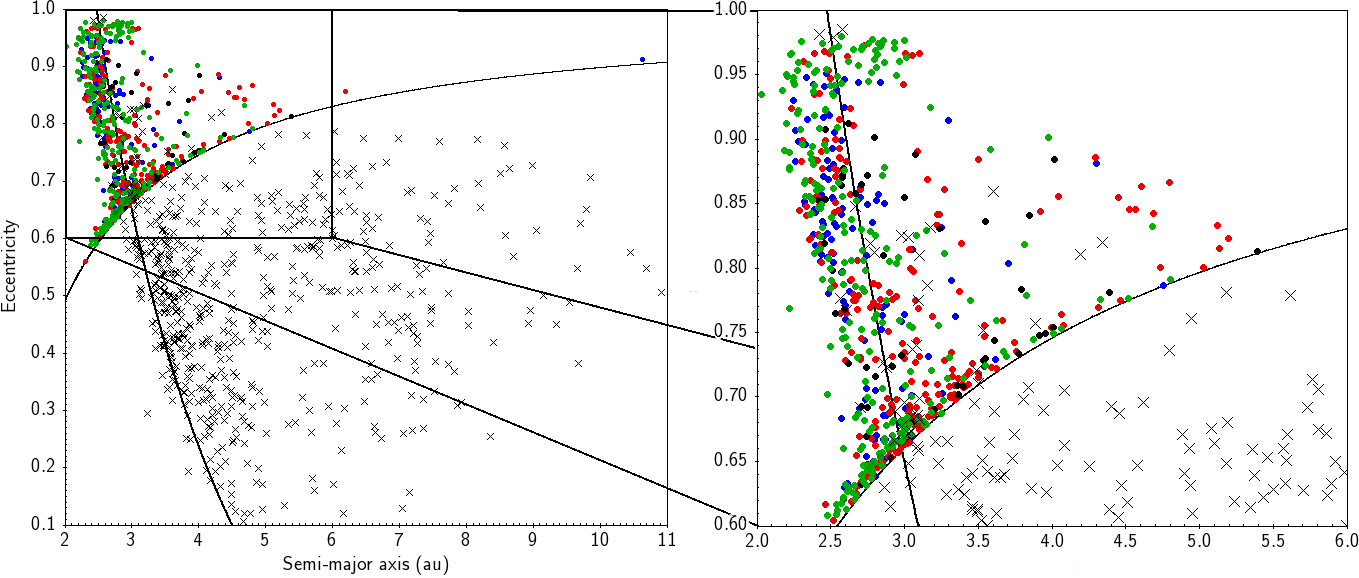The contribution of Jupiter-family comets to the fireball population
- 1Paris Observatory, IMCCE, Paris, France (planetarypat@gmail.com)
- 2Departmento de Astronomía, Facultad de Ciencias, Iguá 4225, 11400 Montevideo, Uruguay
- 3Space Science and Technology Centre, Curtin University, GPO Box U1987, Perth WA 6845, Australia
- 4International Centre for Radio Astronomy Research, Curtin University, GPO Box U1987, Perth WA 6845, Australia
- 5Astronomical Institute of the Romanian Academy, Cutitul de Argint 5, 040557 Bucharest, Romania
Background
Jupiter-family comets (JFCs) are distinct low-inclination comets predominantly originating from the Kuiper belt and the scattered disk. These regions, extending beyond Neptune’s orbit, are home to icy primitive bodies that have retained many of their volatile components. JFCs, characterized by their short orbital periods (<20 years) and Tisserand's parameter (2 < TJ < 3), occasionally venture into the inner solar system, where they become visible due to solar heating-induced sublimation. Their trajectories into the inner part of the solar system are characterized by chaotic interactions with Neptune and, in particular, Jupiter. Previous studies have shown that these frequent close encounters with Jupiter give JFCs an exceptionally short dynamical "memory," with Lyapunov lifetimes concentrating towards 50-150 yrs [1, 2, 3, 4]. The frequent chaotic close encounters provide a very unique dynamical signature to the group that can be used to assess what objects likely originate from the JFC population, even for inactive bodies or meteoroids [5, 6, 3, 7].
Methods
Our study investigates the dynamics and population distribution of JFCs, focusing on their contribution to near-Earth objects (NEOs) and the fireball population. We investigated data from the NASA HORIZONS database (https://ssd.jpl.nasa.gov/horizons/) along with data from multiple of the world`s largest fireball observation networks. We compared the trajectories and physical characteristics of 661 telescopically observed JFCs and 646 fireballs (Fig. 1) observed by the Desert Fireball Network (DFN; https://dfn.gfo.rocks/), European Fireball Network (EFN), Fireball Recovery and InterPlanetary Observation Network (FRIPON; https://fireball.fripon.org/), and Meteorite Observation and Recovery Project (MORP) [8, 9]. The fireball data was limited to objects fitting the Tisserand`s parameter definition of a JFC. The statistical analysis assessed the orbital elements and the frequency of close encounters within the populations over a 10,000 yr integration time period using the Rebound N-body Python library and the IAS15 integrator with all planets included [10, 11].

Fig. 1 Fireball data from DFN (blue dots), EFN (red diamonds), FRIPON (green triangle), and MORP (black squares) with 2 < TJ < 3. Also plotted, the 661 JFCs integrated in this study taken from NASA's HORIZONS database are shown as black crosses.}
Results
Our comprehensive analysis reveals significant insights into the nature and origins of objects on JFC-like orbits. We identified nine established meteor showers within the datasets from the DFN, EFN, MORP, and FRIPON networks, accounting for approximately 17% of the JFC-like fireballs. Showers such as the Quadrantids, Southern δ-Aquariids, and α-Capricornids were detected, with varying levels of shower associations across the networks. Interestingly, the October Draconids were identified as the only shower with dynamics consistent with typical JFCs, suggesting it may be the only pristine JFC material in our sample.
At the kilometer scale, the 661 JFCs exhibited frequent close encounters with Jupiter, resulting in rapid and significant changes in their orbits. Interestingly, 30% of near-Earth JFCs showed stable trajectories over 10,000 years, suggesting potential asteroidal contamination consistent with previous studies [6, 12]. However, the dynamics of the JFCs significantly contrast with the centimeter-to-meter scale meteoroids, where the vast majority originate from stable orbits. Only 8-21% of these meteoroids likely experienced close encounters with Jupiter over the 10,000-year integrations, indicating a different source or evolution compared to kilometer-scale JFCs [3, 4].
The Kozai resonance-induced circulation of the argument of perihelion (ω) was observed to protect many meteoroids from close encounters with Jupiter, contributing to their stability. This resonance effect, particularly prevalent among bodies like 96P/Machholz and Marsden group comets, indicates that these objects may contribute significantly to the meteoroid population. Our findings highlight the need for a nuanced understanding of small bodies' sources and evolutionary paths in the solar system. The JFC-like fireballs detected by fireball networks appear to be influenced by asteroidal contamination and survival biases, with only a small fraction consistent with pristine JFC material.
Conclusions
The observed differences in dynamical behavior between kilometer-scale JFCs and centimeter-to-meter-scale meteoroids underscore the varied evolutionary processes affecting these populations and the significance of the size dependence on source region. The findings suggest that the majority of meteoroids on JFC-like orbits are from stable, non-JFC sources, with only the October Draconids showing typical JFC characteristics. These results emphasize the importance of further research into the origins and dynamics of small solar system bodies and the importance of orbital stability and chaos as a metric for interpreting the source regions of meteoroids [3, 4].
References
How to cite: Shober, P., Tancredi, G., Vaubaillon, J., Devillepoix, H., Deam, S., Anghel, S., Sansom, E., Colas, F., and Martino, S.: The contribution of Jupiter-family comets to the fireball population, Europlanet Science Congress 2024, Berlin, Germany, 8–13 Sep 2024, EPSC2024-338, https://doi.org/10.5194/epsc2024-338, 2024.